When it comes to the compact SUV segment, the Ford Kuga and Toyota RAV4 are two of the top contenders, each offering a blend of practicality, performance, and technology. But how do they stack up against each other? In this article, we will delve into the technical specifications and innovative features of both models to help prospective buyers make an informed decision.
Ford Kuga vs Toyota RAV4 – Which one offers the better deal?
Two cars, one duel: Ford Kuga meets Toyota RAV4.
Which one wins in performance, efficiency and value for money? Find out now!
Design and Dimensions
Both the Ford Kuga and Toyota RAV4 showcase a contemporary SUV design that appeals to a wide range of consumers. The Kuga measures between 4604 mm and 4645 mm in length and stands at a height of approximately 1673 to 1681 mm, giving it a commanding presence on the road. In comparison, the RAV4 is slightly shorter at 4600 mm but has a taller stance at 1685 mm, which may offer a better view of the road ahead.
In terms of width, the Kuga is broader at 1882 mm compared to the RAV4’s 1855 mm. This extra width translates to a bit more shoulder room for passengers inside the Kuga's cabin.
Powertrains and Performance
The Ford Kuga boasts a diverse lineup of engine options, including petrol, full hybrid, and plug-in hybrid engines, with power outputs ranging from 150 to 243 HP. The hybrid models provide impressive fuel efficiency, with consumption figures as low as 0.9 L/100 km when in electric mode, along with an electric-only range of up to 69 km.
On the other hand, the Toyota RAV4 focuses on hybrid and plug-in hybrid powertrains, with a maximum output of 306 HP. Its efficiency is commendable as well, with fuel consumption figures around 5.6 L/100 km for the hybrid models and an electric range peaking at 75 km. While the Kuga can achieve an acceleration from 0-100 km/h in as little as 7.3 seconds, the RAV4 outpaces it with a stunning 0-100 km/h time of just 6 seconds for its performance hybrid variant.
Interior Comfort and Cargo Space
Both vehicles comfortably seat five passengers, but the RAV4 has the edge in cargo space, offering between 520 to 580 liters depending on the trim. The Kuga offers a more modest trunk capacity of 412 liters. This makes the RAV4 a more suitable choice for families or those who need extra space for luggage and gear.
When it comes to interior technology, both models are equipped with modern infotainment systems. The Kuga features Ford’s SYNC infotainment setup, while the RAV4 showcases Toyota's latest multimedia system with enhanced connectivity options. Both systems include smartphone integration, ensuring a seamless connection for drivers and passengers alike.
Safety and Innovations
Safety is a crucial element for SUV buyers, and both the Kuga and RAV4 come loaded with advanced safety features. The Kuga includes Ford's Co-Pilot360 suite, which comprises adaptive cruise control, lane-keeping assistance, and pre-collision assist among other features. The RAV4 is no slouch either, featuring Toyota Safety Sense, which includes automatic emergency braking, dynamic radar cruise control, and lane departure alert.
Additionally, the Kuga offers various driving modes that enhance performance under different conditions, whether it be city driving or off-road adventures. The RAV4 also presents a choice of driving modes and comes with a unique off-road package in some variants, making it well-equipped for adventurous outings.
Final Verdict
Ultimately, the Ford Kuga and Toyota RAV4 each have their own strengths. The Kuga impresses with its varied engine lineup and slightly more spacious cabin for passengers, while the RAV4 shines with its larger cargo area, superior performance in hybrid variants, and a comprehensive suite of safety technologies.
For buyers who prioritize practicality and electric range, the RAV4 stands out, but those looking for performance and a broader choice of powertrains may lean towards the Kuga. The choice will depend on individual needs, lifestyle, and driving preferences, but both models represent excellent options within the competitive compact SUV market.
Here’s where it gets real: The technical differences in detail
Costs and Efficiency:
When it comes to price and running costs, the biggest differences usually appear. This is often where you see which car fits your budget better in the long run.
Ford Kuga has a slight advantage in terms of price – it starts at 34200 £, while the Toyota RAV4 costs 35100 £. That’s a price difference of around 892 £.
Fuel consumption also shows a difference: Toyota RAV4 manages with 1 L and is therefore clearly more efficient than the Ford Kuga with 2.80 L. The difference is about 1.80 L per 100 km.
As for range, the Toyota RAV4 performs slight better – achieving up to 75 km, about 7 km more than the Ford Kuga.
Engine and Performance:
Power, torque and acceleration are the classic benchmarks for car enthusiasts – and here, some clear differences start to show.
When it comes to engine power, the Toyota RAV4 has a evident edge – offering 306 HP compared to 243 HP. That’s roughly 63 HP more horsepower.
In acceleration from 0 to 100 km/h, the Toyota RAV4 is noticeable quicker – completing the sprint in 6 s, while the Ford Kuga takes 7.30 s. That’s about 1.30 s faster.
In terms of top speed, the Ford Kuga performs minimal better – reaching 200 km/h, while the Toyota RAV4 tops out at 180 km/h. The difference is around 20 km/h.
Space and Everyday Use:
Beyond pure performance, interior space and usability matter most in daily life. This is where you see which car is more practical and versatile.
Both vehicles offer seating for 5 people.
In curb weight, Ford Kuga is to a small extent lighter – 1526 kg compared to 1745 kg. The difference is around 219 kg.
In terms of boot space, the Toyota RAV4 offers evident more room – 580 L compared to 412 L. That’s a difference of about 168 L.
In maximum load capacity, the Toyota RAV4 performs slight better – up to 1690 L, which is about 156 L more than the Ford Kuga.
When it comes to payload, Toyota RAV4 barely noticeable takes the win – 600 kg compared to 550 kg. That’s a difference of about 50 kg.
Who comes out on top?
Overall, the Toyota RAV4 shows itself to be dominates this comparison and secures the title of DriveDuel Champion.
It convinces with the more balanced overall package and proves to be the more versatile choice for everyday use.
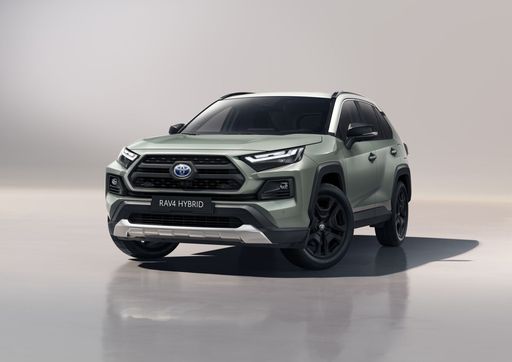 @ Toyota Motor Corporation
@ Toyota Motor Corporation
Toyota RAV4
Ford Kuga
The Kuga is Ford’s adaptable family SUV that blends usable space with a surprisingly lively driving character, making daily commutes and weekend escapes equally enjoyable. With smart interior packaging, an easy-to-use infotainment setup and composed road manners, it’s a sensible choice for buyers who want a bit of fun without the fuss.
details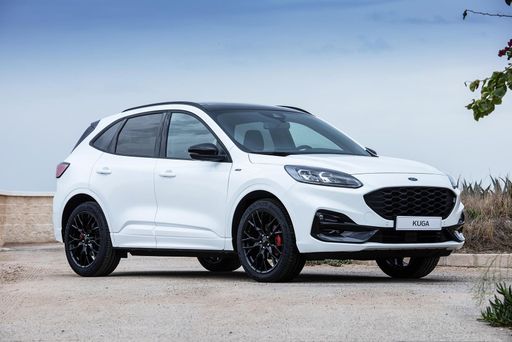 @ Ford Motor Company / Ford Media Center
@ Ford Motor Company / Ford Media Center
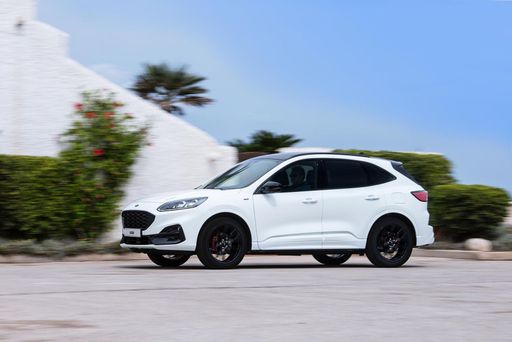 @ Ford Motor Company / Ford Media Center
@ Ford Motor Company / Ford Media Center
 @ Ford Motor Company / Ford Media Center
@ Ford Motor Company / Ford Media Center
Toyota RAV4
The Toyota RAV4 feels like a sensible friend on the road, marrying dependable practicality with a dash of SUV personality that keeps daily driving from turning dull. Comfortable and easy to live with, it looks tough without shouting and quietly gets the job done — a sensible pick for buyers who want versatility without drama.
details @ Toyota Motor Corporation
@ Toyota Motor Corporation
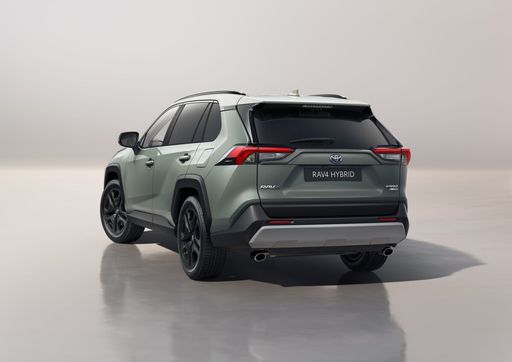 @ Toyota Motor Corporation
@ Toyota Motor Corporation
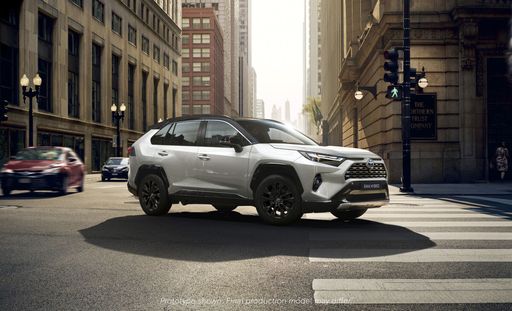 @ Toyota Motor Corporation
@ Toyota Motor Corporation
 @ Toyota Motor Corporation
@ Toyota Motor Corporation
 @ Ford Motor Company / Ford Media Center
@ Ford Motor Company / Ford Media Center
|
 @ Toyota Motor Corporation
@ Toyota Motor Corporation
|
|
|
|
Costs and Consumption |
|
|---|---|
|
Price
34200 - 46300 £
|
Price
35100 - 55700 £
|
|
Consumption L/100km
2.8 - 6.8 L
|
Consumption L/100km
1 - 5.6 L
|
|
Consumption kWh/100km
-
|
Consumption kWh/100km
-
|
|
Electric Range
68 km
|
Electric Range
75 km
|
|
Battery Capacity
1.1 - 14.4 kWh
|
Battery Capacity
-
|
|
co2
55 - 154 g/km
|
co2
22 - 128 g/km
|
|
Fuel tank capacity
42 - 54 L
|
Fuel tank capacity
55 L
|
Dimensions and Body |
|
|---|---|
|
Body Type
SUV
|
Body Type
SUV
|
|
Seats
5
|
Seats
5
|
|
Doors
5
|
Doors
5
|
|
Curb weight
1526 - 1859 kg
|
Curb weight
1745 - 1910 kg
|
|
Trunk capacity
412 L
|
Trunk capacity
520 - 580 L
|
|
Length
4604 - 4645 mm
|
Length
4600 mm
|
|
Width
1882 mm
|
Width
1855 mm
|
|
Height
1673 - 1681 mm
|
Height
1685 mm
|
|
Max trunk capacity
1534 L
|
Max trunk capacity
1604 - 1690 L
|
|
Payload
541 - 550 kg
|
Payload
390 - 600 kg
|
Engine and Performance |
|
|---|---|
|
Engine Type
Petrol, Full Hybrid, Plugin Hybrid
|
Engine Type
Full Hybrid, Plugin Hybrid
|
|
Transmission
Manuel, Automatic
|
Transmission
Automatic
|
|
Transmission Detail
Manual Gearbox, CVT, Automatic Gearbox
|
Transmission Detail
CVT
|
|
Drive Type
Front-Wheel Drive, All-Wheel Drive
|
Drive Type
Front-Wheel Drive, All-Wheel Drive
|
|
Power HP
150 - 243 HP
|
Power HP
218 - 306 HP
|
|
Acceleration 0-100km/h
7.3 - 9.9 s
|
Acceleration 0-100km/h
6 - 8.4 s
|
|
Max Speed
195 - 200 km/h
|
Max Speed
180 km/h
|
|
Torque
240 Nm
|
Torque
-
|
|
Number of Cylinders
3 - 4
|
Number of Cylinders
4
|
|
Power kW
111 - 178 kW
|
Power kW
160 - 225 kW
|
|
Engine capacity
1496 - 2488 cm3
|
Engine capacity
2487 cm3
|
General |
|
|---|---|
|
Model Year
2025
|
Model Year
2024 - 2025
|
|
CO2 Efficiency Class
E, D, B
|
CO2 Efficiency Class
D, B
|
|
Brand
Ford
|
Brand
Toyota
|
What drivetrain options does the Ford Kuga have?
The Ford Kuga is available as Front-Wheel Drive or All-Wheel Drive.
The prices and data displayed are estimates based on German list prices and may vary by country. This information is not legally binding.
